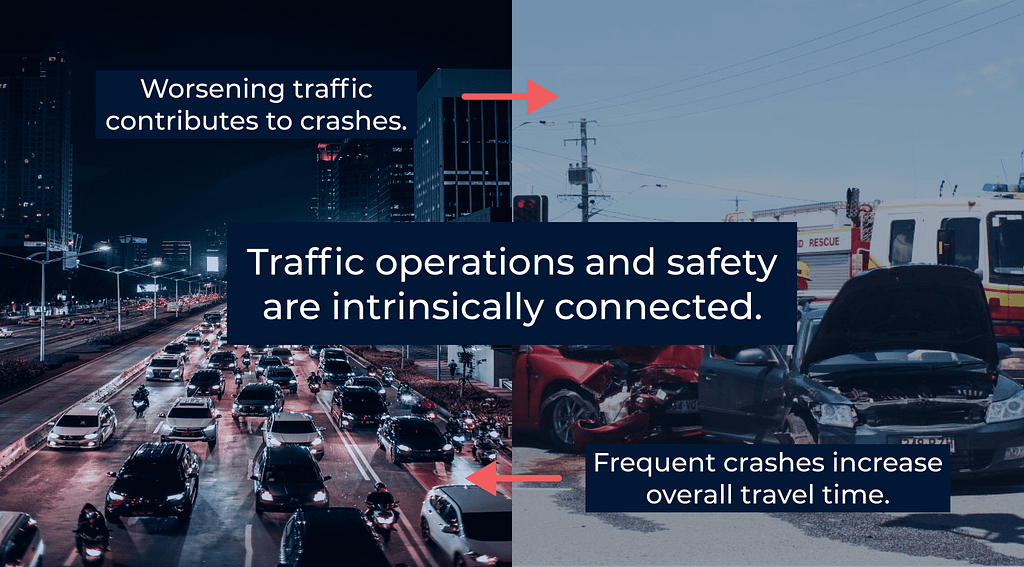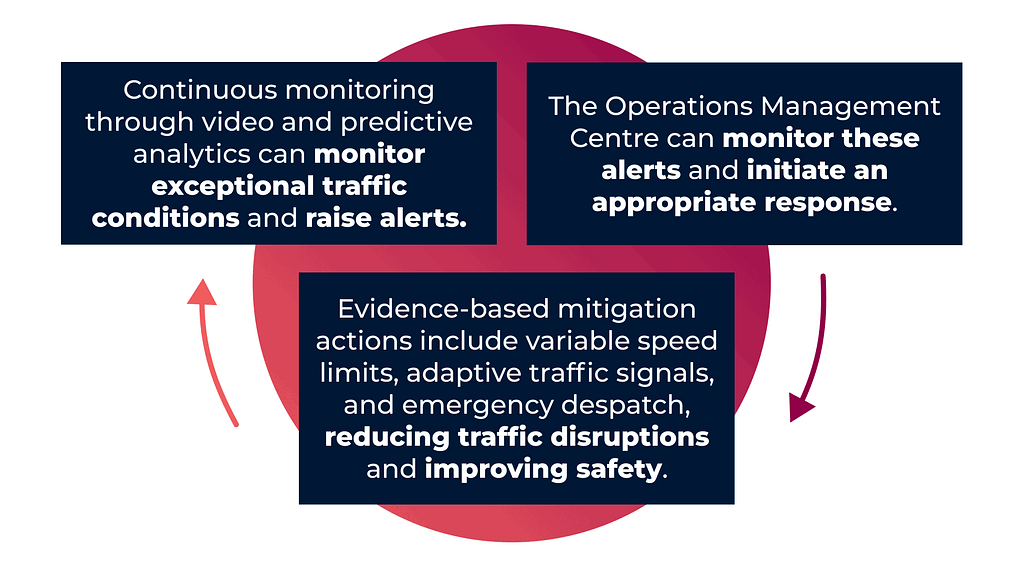What is the difference between Road Safety and Transportation Operations?
In essence, success for a traffic operator is an uncongested road.
Their focus is on delivering safe and efficient transport systems, through compliance with design and operational guidelines. Efficiency is achieved through how a network is managed: traffic operators are proactive.
Conversely, road safety managers are reactive. They identify deficiencies of operations that result in crashes, and devise solutions. Their measure of success is a reduction in injuries and fatalities on transport networks.
The common link that bridges the gap between these two disciplines of practice: mitigation of crashes and congestion.
Data Analysis Metrics in Transportation Industry
The operational efficiency of a transport network is primarily measured by mobility metrics like travel times, delays, queues and average speeds, whereas safety assessment relies on the count and severity of crashes.
| Traffic Operations | Road Safety | Travel Times | Crash Count |
|---|---|
| Delays | Crash Severity |
| Queues | |
| Average Speeds |
Safe Systems Approach to Road Safety
In Australia, the Safe Systems Approach seeks to cultivate a more proactive and holistic approach to road safety. This policy goal requires a shift in focus from retrofitting safety once all the mobility objectives have been met, to maximizing mobility within the limits of safe operations.

The ability to reliably predict crash risk as a function of operating conditions is a fundamental requirement for this seismic shift in the way transportation networks are managed.
There are a number of pathways to support this shift:
1. Transportation Planning and Traffic Control Operations
Considering safety explicitly within transport planning and traffic control operations can pay high dividends. For instance, the operations of a well-planned and built motorway can have efficiency deficiencies as a result of frequent crashes or incidents that impede traffic flow, leading to generally longer travel times and associated costs – contrary to operational objectives.
2. Road Safety Improvements
Road safety improvements should aim to achieve short and reliable travel times. An excessive increase in travel times can escalate anxiety among road users leading to unsafe on-road behavior.
Recent research has shown that optimizing road transport facilities for both safety and efficiency is both possible and desirable given that safety benefits can be obtained without substantial loss of efficiency.[1]
3. Monitoring and Measuring Traffic Operations and Road Safety
Managing both operations and safety requires adequate monitoring and measurement. Unfortunately, conventional evidence-based traffic safety practices rely on historical crash data. The issue being that transportation crash data is collected for 3-5 years where safety problems and mitigative measures are identified. This approach is ill-suited for the task of continuous monitoring of traffic safety and operations.
In stark contrast, the measurement of traffic conflicts can do this job extremely well. Systematic critical conflicts, aka near-crashes or near-misses, are indicative of traffic conditions that give rise to crashes over time. Critical conflicts convey clues about the underlying operational conditions that create unsafe traffic behaviors, leading ultimately to crashes.
The “nearness” of a traffic conflict event to an actual crash event is measured using indicators, aptly called conflict indicators or conflict measures. Well-known metrics like Time-to-Collision (TTC) and Post-Encroachment Time (PET) are examples of such conflict measures. Some sources use the phrase ‘surrogate measures of safety’ because they are indirect indicators of the inherent crash risk of a traffic interaction.
These conflict measures are conducive to continuous measurement and can be used as real-time indicators of a potential breakdown of traffic flow. If crash risk, measured as a function of these conflict measures, increases at a traffic location, then there is a higher chance of observing an actual crash, which will disrupt the traffic operations. Thus, conflict measures can be combined with operational metrics such as flows and speeds to continuously monitor traffic operations at a traffic location, corridor, or network–leading to more effective and proactive traffic management.
This measurement of critical conflicts can be achieved by harnessing the advantages of modern-day technologies like Computer Vision-based crash predictive analytics, as implemented in AMAG’s SMART Operations Monitoring Product.
AMAG’s SMART Operations Monitoring
AMAG’s SMART Operations platform works by using the continuous video feed from existing infrastructure (think street and traffic lights), or adding additional High Definition Cameras with High Dynamic Range (HDR) coupled with real-time algorithms and edge enabled technology. This transportation analytics enables constant monitoring of crashes, traffic conflicts, road user flows, violations and speeds.
Using highly configurable scenarios (commonly referred to as alerts under event or incident based detection), the platform produces alerts when a transport network location undergoes a significant change from baseline operations. The platform also takes into consideration the natural fluctuations by time of day and season.
When a safety or operations deterioration is detected, the SMART Operations product issues alerts prompting the road user agencies to inspect site operations, dispatch emergency response units in case of a collision, and/or conduct a deep dive diagnostic analysis through the SMART Safety Product utility of the AMAG SMART platform for long-term safety benefits.
SMART Operations is constantly monitoring not only events but also collecting and analyzing information critical for transport planning. The metrics produced from the platform under traffic engineering terminology is referred to as a continuous base case assessment. Here, the platform provides at a site level within a network the level of service, delay, queues, degree of saturation and lane utilization; critical metrics that inform development interventions required for improved traffic operations.
Traffic Management Center Improvements
Current practice at Traffic Management Centers (TMCs) requires traffic professionals to manually monitor traffic operations on selected corridors through networks of cameras, with certain traffic feeds triggering alerts. These monitoring activities would be greatly enhanced by applying automated video analytics to monitor traffic conflicts and other risk-related metrics (e.g. speeding, violations). Using this video analytics for continuous risk monitoring would enable the monitoring of traffic risks and risk trends, so that unacceptable and incident-induced congestion could also be avoided. Improved management of Variable Speed Limits and reduced dispatching of emergency vehicles to incidents would be expected as a result.
AMAG’s SMART Operations is designed to achieve these objectives. It continuously measures numerous risk-related metrics, including flows, speeds, violations and traffic conflicts. It compares current risk with historic risk to inform current operations and alert operations managers. Moreover, the platform is designed to be scalable, meaning that it can efficiently manage many locations or traffic corridors.

Video and Transportation Analytics
A significant advantage of video analytics is collecting traffic violations data, which are notoriously difficult to collect. The predictive capabilities of AI-based systems enable monitoring of exceptional road user behaviors as well.
For example, a video-based advanced intersection management system can continuously monitor the speed and acceleration profiles of dilemma zone vehicles during amber phases to predict their red-light-running likelihood. If a vehicle is predicted not to clear an intersection by the start of the next phase, an alert can be issued to the traffic controller to extend the all-red phase to allow its safe passage through the intersection.
Only video-based monitoring can monitor pedestrian spatial and temporal violations at pedestrian crossings and wrong-way bicycle riding in an automated fashion. Often these violations are indicative of operational or road user issues that may require targeted treatment.
Video and Predictive Analytics: A Solution for Road Safety and Transportation Operations
Combining computer vision and predictive analytics will accelerate our readiness for the deployment of advanced technologies like Adaptive Traffic Signal Safety Systems, connected vehicles and self-driving vehicles. Since such technologies are poised to improve both the safety and efficiency of traffic operations significantly, widespread adoption of automated video-based traffic management systems can revolutionize the way we manage transport networks and, ultimately, bridges the gap between road safety and traffic operations.
[1] Stevanovic, A., Stevanovic, J. and Kergaye, C. 2013. Optimization of traffic signal timings based on surrogate measures of safety. Transportation Research Part C: Emerging Technologies, 32, 159-178.
[2] https://amagroup.io/news/measuring-critical-conflicts-for-crash-prediction/
[3] Tageldin, A., Sayed, T., Zaki, M. H., & Azab, M. (2014). A safety evaluation of an Adaptive Traffic Signal Control system using Computer Vision. Advances in transportation studies.